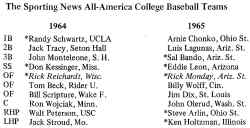
| What Happens to College All-America Selections? |
 |
 |
|
What Happens to College All-America Selections? By Tom Hufford It is an accepted fact that the nation's colleges have made a significant contribution to major league baseball over the last 20 years. They have provided an expanded training ground for future professional players in a period when the major leagues were being increased in size and the minor leagues were not. How can this contribution be measured? Part of it can be measured by reviewing the annual All-America College Baseball Teams selected by The Sporting News from 1964 to 1981. These selections actually have been made for TSN by the leading professional baseball scouts and more recently by the scouting directors of the major league clubs. In the early years a team of ten players was selected with a lefthanded pitcher and a righthanded pitcher. Occasionally there would be a tie for one position. Since 1976 a designated hitter was added to the team. How many of these All-America selections went into professional baseball and how many made it to the majors? Almost all gave professional baseball a trial. In fact, many were so eager to go that route that they left before finishing college. This is reflected by the college-year level of the selectees. Take the 1968 class for example. Two were sophomores, including Steve Garvey, six were juniors, including Thurman Munson, and two were seniors, including Tom Paciorek. The 1965 selections included four sophomores, one being Rick Monday of Arizona State, the Player of the Year. He was the number one pick in the first free-agent draft on June 8, 1965, and was signed by the Kansas City A's for a reported $104,000 bonus. Another 1965 sophomore, Ken Holtzman of Illinois, signed with the Cubs for $65,000. In 1966, Reggie Jackson of Arizona State also won Player of the Year honors as a sophomore, and immediately signed with Kansas City for a bonus of $90,000. Approximately 55 percent of the All-America selections from 1964 to 1981 made it to the majors. This percentage will probably be increased with additional names from the 1989 and 1981 teams. Two college players - Dave Winfield and Bob Homer - went straight to the majors and never have played in the minors. Other All-America players who have reached stardom in the majors include Mike Schmidt, Reggie Jackson, Steve Garvey, Don Kessinger, Sal Bando, Thurman Munson, Fred Lynn, Dave Kingman, Ken Holtzman, and Burt Hooton. The aforementioned Rick Monday is the longevity leader with 17 years in the majors. One of the college players - Tom Harmon, Texas 1970 - never made it to the majors as a player, but he did show up as a coach with the Chicago Cubs in 1982. Two who did make it, met with tragedy. Danny Thomas of the 1972 class was a suicide in 1980, and Mike Miley, class of 1974, died in an auto wreck in 1977. It is not always easy to predict the professional impact of top college players. Several chosen as College Player of the Year fizzled in major league trials. The list includes, for various reasons, Dave Lemonds, Paul Powell, Rob Ellis, Eddie Bane, and Danny Goodwin. On the other hand, most of those who were two-time All-America selections have done quite well in the majors. There were 13 of those, including Burt Hooton of Texas, who was selected in non-consecutive years. He was the righthanded pitcher in 1969 as a 19-year-old freshman. Although he had an excellent year in 1970, he lost out to Steve Dunning of Stanford, the Player of the Year. Hooton made the team again in 1971 as a junior, and then turned pro. Some college players played different positions when they got to the majors. For example, college outfielder Dave Stieb now pitches for Toronto. What college teams produced the most All-America selections in these 18 years? Although the University of Southern California did very well with 17 selections, Arizona State took the cake with 20 selections, including four from their great 1976 team. Arizona State also had seven College Players of the Year in those 18 years. In 1978, when USC won the NCAA baseball championship, they filled both pitching positions on the All-America team. Rod Boxberger was the top right-hander, and Bill Bordley the leading lefty. There follows The Sporting News All-America Collegiate Baseball Teams from 1964 to 1981. Italics indicate the College Player of the Year. Asterisks indicate that the player played in the major leagues. |

 What Happens to COllege All-American Selections?
What Happens to COllege All-American Selections?

